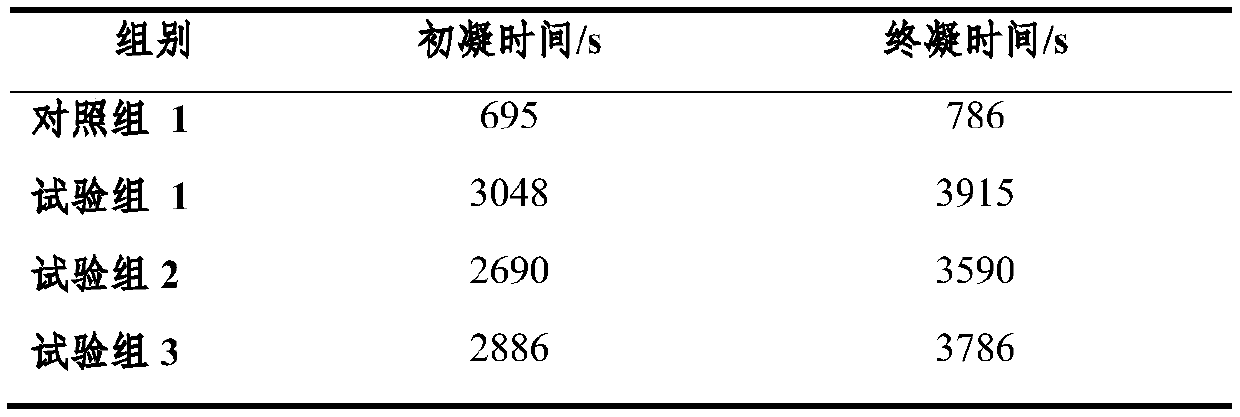A kind of retarded calcium magnesium silicate phosphate cement and preparation method thereof
A technology of slow-setting calcium phosphate and cement, which is applied in the field of building materials, can solve the problems of prolonging the setting time and decreasing compressive strength, and achieve the effects of delaying the setting time of cement, high early strength and shortening the construction period
- Summary
- Abstract
- Description
- Claims
- Application Information
AI Technical Summary
Problems solved by technology
Method used
Image
Examples
Embodiment 1
[0025] The raw material is: diammonium hydrogen phosphate (P 2 o 5 ≧25%, N≧20%) 26.8kg, monoammonium phosphate 4.4kg, magnesium chloride 54.8kg, fly ash 8.8kg, borax 0.4kg, potassium dihydrogen phosphate 0.4kg, calcium chloride 4.4kg.
[0026] Step 1: Grind magnesium chloride, calcium chloride, borax and fly ash to 400 mesh, and potassium dihydrogen phosphate, industrial monoammonium and diammonium phosphate to 180 mesh.
[0027] Step 2: Take the above-mentioned finely ground raw materials and put them into a blender for mixing.
[0028] Step 3: Put the uniformly stirred mixture into a dryer for drying at a temperature of 150° C. to obtain calcium silicate magnesium phosphate cement.
Embodiment 2
[0030] The raw material is: diammonium hydrogen phosphate (P 2 o 5 ≧30%, N≧15%) 20.2kg, monoammonium phosphate 10.1kg, magnesium chloride 33.5kg, fly ash 23kg, borax 1.9kg, potassium dihydrogen phosphate 1.7kg, calcium chloride 9.6kg.
[0031] Step 1: Grind magnesium chloride, calcium chloride, borax and fly ash to 200 mesh, and potassium dihydrogen phosphate, industrial monoammonium and diammonium phosphate to 100 mesh.
[0032] Step 2: Take the finely ground above-mentioned raw materials and put them into a mixer for mixing according to the mass ratio of the cement.
[0033] Step 3: Put the evenly stirred mixture into a dryer for drying at 60° C. to prepare calcium silicate magnesium cement.
Embodiment 3
[0035] The raw material is: diammonium hydrogen phosphate (P 2 o 5 ≧40%, N≧5%) 30.2kg, monoammonium phosphate 15.1kg, magnesium chloride 17.7kg, fly ash 31.6kg, borax 0.4kg, potassium dihydrogen phosphate 0.6kg, calcium chloride 4.4kg.
[0036] Step 1: Grind magnesium chloride, calcium chloride, borax and fly ash to 200-400 mesh, potassium dihydrogen phosphate, industrial monoammonium phosphate and diammonium phosphate to 100-180 mesh.
[0037] Step 2: Take the finely ground above-mentioned raw materials and put them into a mixer for mixing according to the mass ratio of the cement.
[0038] Step 3: put the uniformly stirred mixture into a dryer for drying at 100°C to obtain calcium silicate magnesium cement.
PUM
| Property | Measurement | Unit |
|---|---|---|
| particle size | aaaaa | aaaaa |
Abstract
Description
Claims
Application Information
 Login to View More
Login to View More - R&D
- Intellectual Property
- Life Sciences
- Materials
- Tech Scout
- Unparalleled Data Quality
- Higher Quality Content
- 60% Fewer Hallucinations
Browse by: Latest US Patents, China's latest patents, Technical Efficacy Thesaurus, Application Domain, Technology Topic, Popular Technical Reports.
© 2025 PatSnap. All rights reserved.Legal|Privacy policy|Modern Slavery Act Transparency Statement|Sitemap|About US| Contact US: help@patsnap.com



